Africa
The continent is considered the birthplace of mankind. The greatest civilization developed later in Egypt - see the chapters concerning the Mediterranean Sea. From the 7th century A.D. the Arabs spread Muslim religion to Africa. In the 15th century the Europeans discovered the continent south of the Sahara. Then the age of colonialism began.
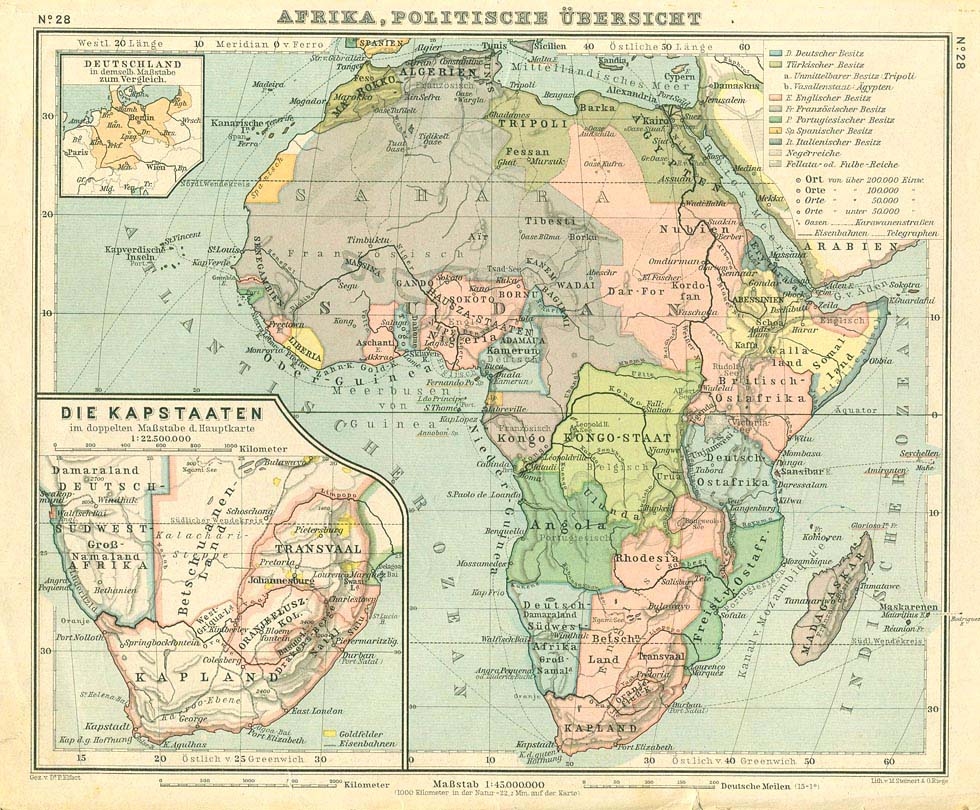
Africa, map of 1904 (coll. Karl Danz, WS)
In the 19th century the ports of Africa were connected by steamship companies in strictly European ownership, more for cargo than for the few passengers. The West Coast ports generally have been linked by mail lines and passenger-cargo services from Europe - see main chapter South Atlantic. In some cases coastal feeder lines were added, e.g. by Elder Dempster Lines, reducing the need for through-sailings. In contrast to the West Coast, the East Coast and the Indian Ocean were a playground for a multitude of secondary lines, deep-sea and coastal, to be dealt with here.
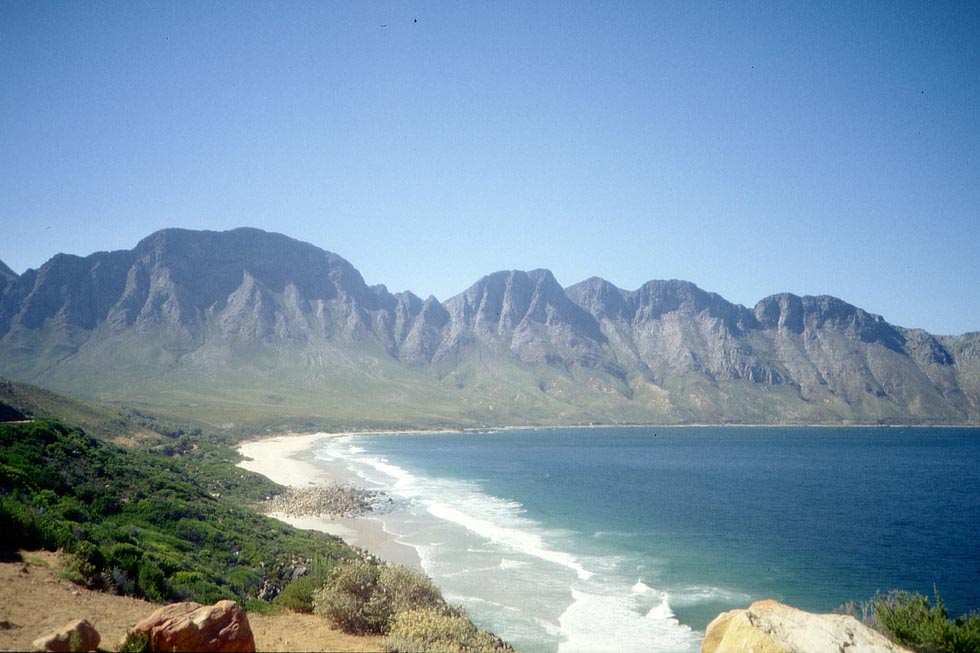
East of the Cape (WS)
British to the East Coast
A Cape Town - Durban coastal service was started in 1857 by the Rennie Line, but four years later the two steamers were lost and not replaced. The British mail carrier Union Line extended South Africa services to Durban in 1863, to Mauritius in 1864 and with a short-lived branch line to Ceylon in 1866. The competing Castle Line added a Mauritius service in 1879. Bullard King & Co. inaugurated in 1891 a coastal service from Durban to Mozambique. From Beira passengers for Rhodesia proceeded up the Pungwe River by the steam tug-boat "Kimberley" to a temporary narrow-gauge railway terminus Fontesvilla, until the waterway became impassable by sandbanks. The Natal Direct Line of Bullard and King had obtained in 1883 a contract for a Calcutta - Durban migrant workers service, which endured for half a century. In 1919 the company was acquired by the Union-Castle Line, but preserved its identity. For the merged Union-Castle Line and their dominating mail route through the South Atlantic see the main chapter South Atlantic/ Britain and Africa.
British India Line
The P&O opened a branch line Aden - Mauritius in 1858 and in the following year extended it to a service Suez - Mauritius - Australia. After change of the Australian Mail to the standard route via Ceylon, the branch line to Mauritius and Reunion was abandoned in 1866. From 1873 the Union Line arranged connection at Zanzibar with a steamer of the British India Line to Aden, an outpost of the telegraph from Europe. In 1888 the British East Africa Co. was awarded the Royal Charter for subjugating East African territory, and its first president was William Mackinnon, founder-member of the British India Line. Mackinnon thought of a railway starting at Mombasa, but only after takeover by the government in 1896 this Uganda Railway could be financed. The timetable towards the end of the 19th century showed British India liners London - Mombasa - Zanzibar, Bombay - East Africa and Calcutta - Mauritius. Obviously the last steamers of the British India Line on the England - Durban route have been the "Kenya" (14,464 gt) and "Uganda" of 1951/52 and on the Bombay - Mombasa - Durban route the "Kampala" (10,304 gt) and "Karanja". The Indian African Line (Bank Line), mentioned by the pre-war timetable with a route Cape Town - Calcutta - Rangoon, of course had also disappeared.
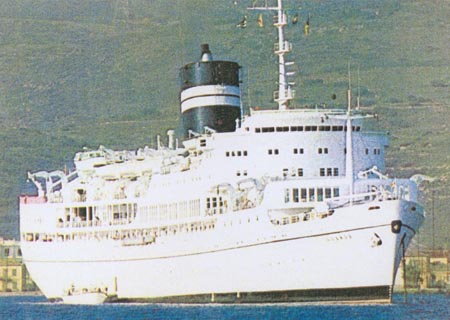 "Uganda" of 1952, formerly British India Line, on an East Africa cruise in 1978 (P&O Cruises)
"Uganda" of 1952, formerly British India Line, on an East Africa cruise in 1978 (P&O Cruises)
French via Suez
Messageries Maritimes of France entered the Indian Ocean after opening of the Suez Canal. Obok at the coast of Ethiopia was acquired by Captain Fleuriot de Langle and became a colony in 1862. From its new harbour Djibouti construction of a railway was started in 1897, intended to reach the French colonies in West Africa. Before WWI the contemporary timetable listed a route Marseilles - Djibouti - Madagascar - Reunion - Mauritius and a branch line to Mozambique. At Reunion island, a French outpost in the Indian Ocean, 70 ships had been smashed on the cliffs before the new harbour Pointe de Galets was built. On the island of Madagascar, a French protectorate since 1885, the harbour Tamatave got a link by the Canal des Pangalanes with the Vohitra river in 1901. By that way the small steamer "Nansen" connected with the railway to the capital Tananarive before the rails reached Tamatave in 1912. Diego Suarez on Magadascar became starting-point of a branch line to Mozambique, Beira and Lourenco Marques (Maputo). Chargeurs Reunis and the Compagnie Havraise Peninsulare de Navigation a vapeur provided passenger-cargo services to the East Coast of Africa.
German to the East Coast
What's now Tanzania had been since 1885 brutally exploited by the Deutsche Ost-Afrika-Gesellschaft, after an upheaval coming under German administration. Zanzibar however was given away in 1890 to Britain, in exchange for Helgoland, the strategic island in the North Sea. In the same year the Reichstag, the German parliament, consented to creation of a subsidized mail line. In 1891 that Deutsche Ost-Afrika-Linie (DOAL) opened the service Hamburg - Dar es Salaam - Lourenco Marques with the steamer "Reichstag" (ex "Eduard Bohlen") of 2,367 tons. Minority shareholder Adolf Woermann managed the new company on account of his experience in the West Coast trade. In 1892 a connecting line Zanzibar - Bombay was added, inaugurated with the tiny "Safari", later extended to Durban - Bombay.
The branch line to Lourenco Marques on the Delagoa Bay achieved a special political importance. That Portuguese-owned harbour (now Maputo) was targeted by the Zuid Afrikaansche Republick of the Boers to become their port and in 1894, under President Krueger, it was connected by the NZASM railway with its capital Pretoria. With the bloody Boer War, Pretoria was definitely incorporated into British-dominated South Africa, its main port being Cape Town. In 1901 the main line of DOAL became the "Rund-um-Africa" (round Africa) route via Cape Town - see chapter South Atlantic/ Other Africa Lines.
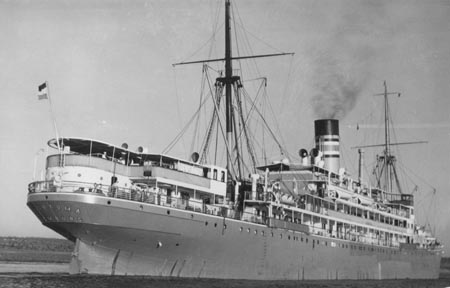
"Ussukuma" of 1921, DOAL (old card, coll. WS)
|
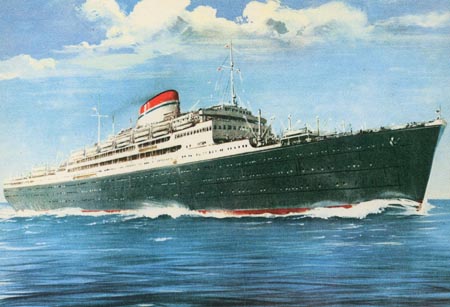
"Vulcania" and "Saturna", then used for troop transports to Ethiopia (old card, coll. WS)
|
Italian East Coast Services
Italy took possession of Assab on the coast of the Red Sea in 1882. For the Christian state of Ethiopia, Menelik II was appointed emperor with Italian help and in 1896 he defeated the Italian troops completely. Neighbouring Eritrea became an Italian colony in 1889. In 1906 an international convention authorized Italy to connect its southern colony Somalia with Eritrea by a railway, which never was completed.
Navigazione Generale Italiana connected Genoa with Massawa in Eritrea and provided a feeder line Massawa - Aden already in the 19th century. Societa Marittima Italiana and Tirrenia followed later. A timetable of the 1930s listed a service Genoa - Dar es Salaam by Tirrenia. Before WWII the 11,398-ton "Iberia" of 1918 was among the vessels being employed. Flotta Lauro started passenger-cargo services to East African ports in 1932. When Italy under Mussolini conquered Ethiopia in 1935/36, using poison gas, troops were transported there by several ships, including the North Atlantic liners "Saturnia" and "Vulcania" of Cosulich and the "Resolute", acquired for that purpose from Hapag, renamed "Lombardia".
Other Countries
Oesterreichischer Lloyd tried an East Africa route only between 1902 and 1906. Portuguese East Africa, now Mozambique, was connected mainly via the South Atlantic - see the chapter South Atlantic/ Other Africa Lines.
Inland Connections
The harbours at the East Coast are of great importance for the countries in the interior of Africa. Mombasa and Dar es Salaam were connected with Uganda by rail and by steamer on Lake Victoria. Where the rails ended on Lake Tanganyika, steamers departed for the Congo and Burundi. Before WWI it had been the German "Goetzen", which was sunk in 1916 and then was re-introduced in the '20s as "Liemba". Congo shipping was provided by companies of various nations, the state-owned Marine du Haut Congo, succeeded by Sonatra, in 1925 by Unatra and in 1936 by Otraca. William Mackinnon of the British India Line had initiated in 1874 construction of a road from Dar es Salaam to Nyasaland, now Malawi. On the lake, named after the country, missionaries started to combat slave trade and in 1875 they got assembled there the first steamer "Ilala" (a new "Ilala" of 1950 crossed the Lake Malawi still in the 21st century). The usual way to that country, after it had become a British colony in 1891, was by a branch line of the Deutsche Ost-Afrika-Linie from Tanga or Beira to Chinde and from there by a British, Portuguese or German Zambesi river steamer to Chiromo, where construction of railways started.
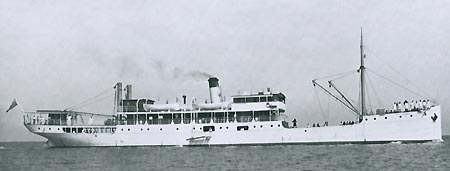 "Liemba" on Lake Tanganyika, the former "Goetzen" (EAR)
"Liemba" on Lake Tanganyika, the former "Goetzen" (EAR)
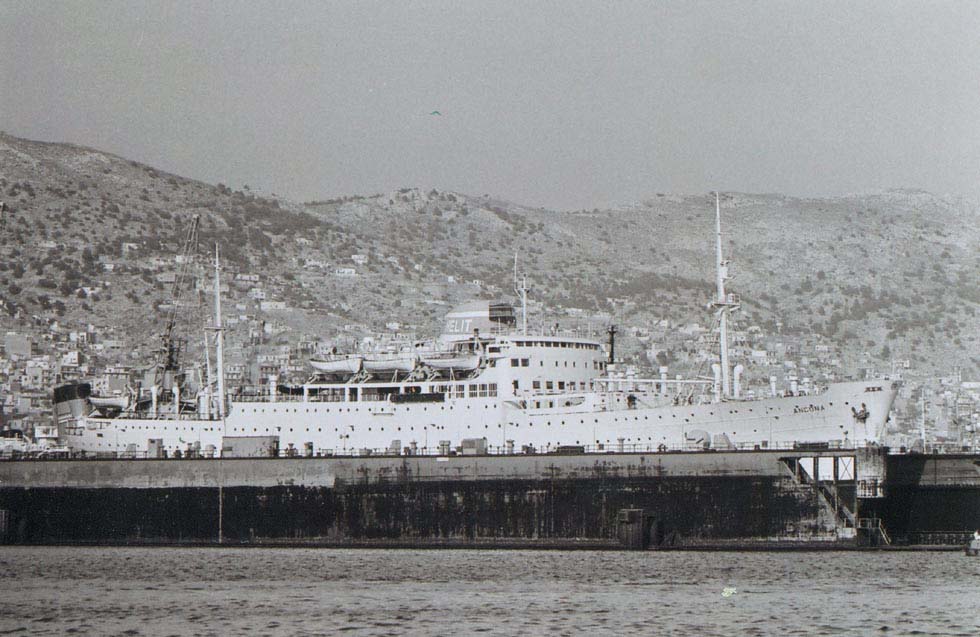
"Ancona" of Helit, one of the Ferdinand de Lesseps sisters of Messageries Maritimes, Perama 1974 (WS)
Post-War East Coast
After WWII the British India Line introduced in 1951 the "Kenya" (14,464 gt) and in 1952 the similar "Uganda", white with a black funnel, on the London - Suez - Durban route. Messageries Maritimes employed from 1952/53 the motor-ships "Ferdinand de Lesseps", "Jean Laborde", "La Bourdonnais" and "Pierre Loti" of c. 11,000 tons each on the Marseilles - Madagascar - Mauritius run. Without doubt the motor-ships "Africa" and "Europa" (14,440 gt each), introduced by Lloyd Triestino in 1952 on the Trieste - Mogadishu - South Africa route, were the most elegant ships on the east coast.
What remained of all the shipping lines on the east coast of Africa? Towards the end of the 1970's, the passenger services of the grand British, French, Italian, Portuguese and German companies had disappeared from the timetables. ABC Shipping Guide of 1978/79 showed only a departure for TFC Tours from Durban via the Suez Canal and Haifa to Piraeus with the motor-ship "Oceanos" (10,909 gt) of Epirotiki Lines, the former "Jean Laborde" of Messageries Maritimes' Mauritius route. Rogers & Co. offered a Mauritius - Seychelles connection with the "Mauritius". Then the only quasi-regular departures from the East African coast were the cruises of the Swiss "Royal Star", the former "San Giorgio" of Adriatica.
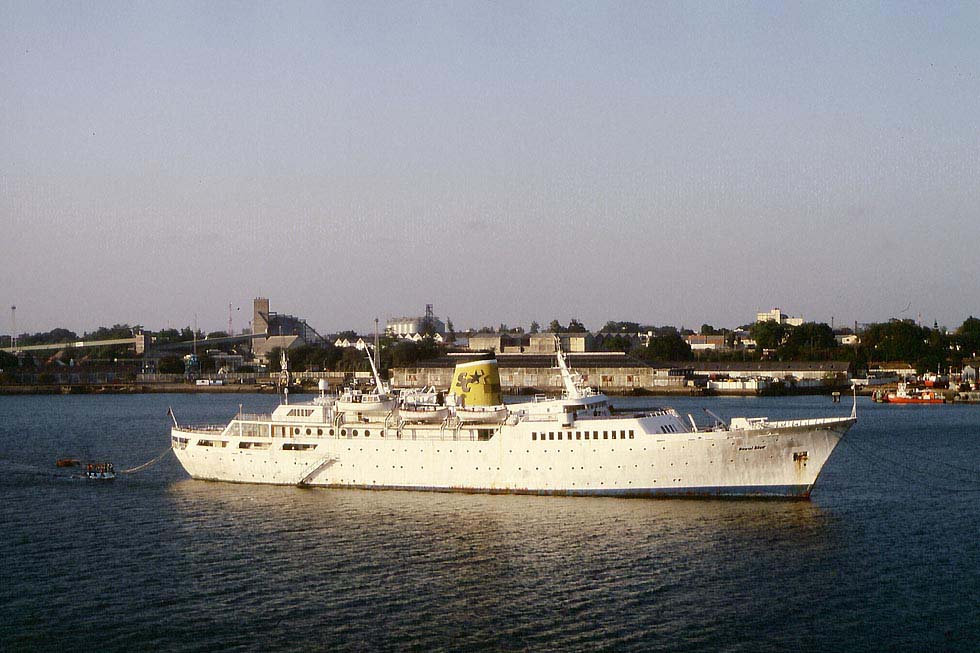
"Royal Star", ex "San Georgio" of Adriatica, Mombasa 2009 (WS)
End of an Epoch
Simultaneously with the end of the ocean liner, a new epoch began also in the history of Africa. West Coast countries from Senegal to Congo were liberated in 1960, followed by East African countries. Mozambique and Angola got rid of colonialism not before 1975. Angola and the former Belgian Congo suffered under civil war. South Africa has become a state already before WWII, but then the horror of 'apartheid' lasted until 1993.
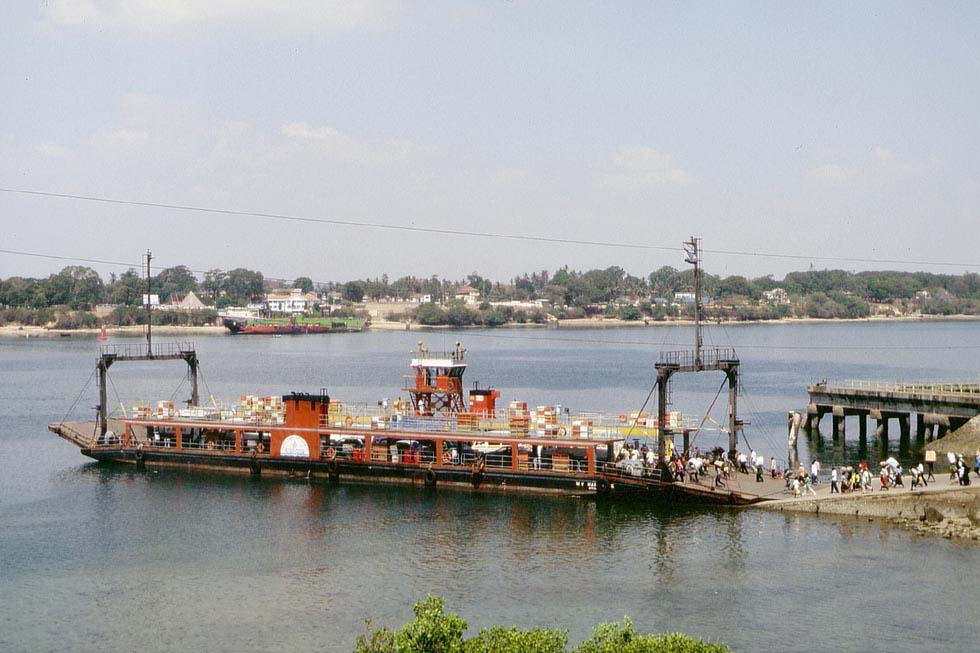
Likoni Ferry, Mombasa 2009 (WS)
East Coast Ferries
Survivors after the turn of the century were a few Mauritius - Reunion services by the Mauritius Shipping Corp., connecting also Taomasina in Madagascar, Seychelles inter-island services, including a fast catamaran of Travel Services, then Cat Co Cos, and a connection Djibouti - Obock by the Port Autonome. For coastal shipping at Madagascar, a new vessel was built there in 1996, supported by the Neue Ruhrorter Schiffswerft of Germany. In the new century, timetables don't give any information. According to Ortel/ Foerster, Ruhrort had delivered from the '60s coastal and inland ferries to Djibouti, Equatorial Guinea, Gabon, Guinea, Niger, Sierra Leone, Tanzania and Central Africa. That renowned source described Dar es Salaam - Zanzibar services by African Shipping Co., Sea Express Services and Zanzibar Shipping Co. Hydrofoils and catamarans of Azam Marine shortened the traveling time from 3 1/2 to 1 1/2 hour. In the 21st century, apart from "Seabus" catamaran services of Azam Maritime, altogether half a dozen companies connected Zanzibar. In Kenya, the tourist may watch the local Likoni Ferry at Mombasa, the historic harbour city. The Tanzania Coastal Shipping Line has provided a service from Dar es Salaam to Mtwara at the border of Mozambique, but then an official information stated that it "has been liquidated". For Mozambique, Ortel/ Foerster has mentioned e.g. the "Africa" (ex "Mons Calpe" of Bland Line). Then Cook's timetable did not list any service in Mozambique.
West Coast Ferries
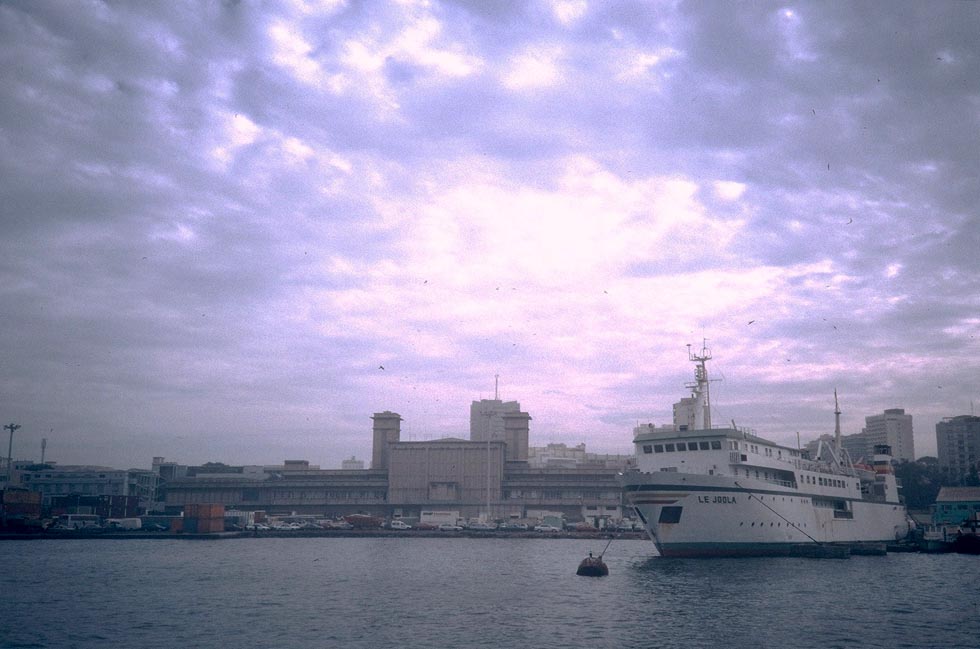
Dakar and "Le Joola" in 2000 (WS)
Routes to Morocco are described with the chapter Iberian Ports. The "Massalia" (10,513 gt), built in 1971 for Canaries services of the Nouvelle Cie. de Paquebots, was used at the end of the '70s on a Marseilles - Dakar route by Paquet Cruises. Senegal is dependent on a shipping route connecting the northern with the southern part of the country, separated by the state of Gambia. Buses crossing Gambia reportedly were raided and a dangerous hinterland route takes five days. Ortel/ Foerster described the shipping service between the capital Dakar and Canabane in the mouth of the Casamance river in the South. In 1990 the "Ile de Carabane I" and "Ile de Carabane II" were introduced, the former "Langelandsbelt" and "Rospiggen". A service between Dakar and Zuiginchor, the capital of the South, by USIMA had been listed by Cook's timetable in the '80s with the remark "temporarily suspended". In 1991 it was resumed with the new "Le Joola" of 1,500 tons, built for Senegal state authorities at Germersheim on the Rhine. With twice the number of passengers as allowed, the ship sank in January 2002 and within minutes 1,863 people died. In 2005 an agreement was concluded with PT Pelni of Indonesia to charter its "Wilis" and SOMAT employed her on that route until 2008. Then the small car ferry "Aline Sitoe Diatta", financed by the EU, continued that service.
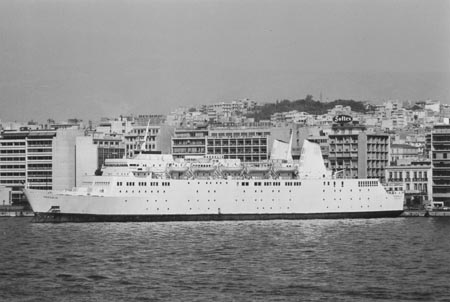
"Massalia", Paquet Cruises, Piraeus 1978 (WS)
|
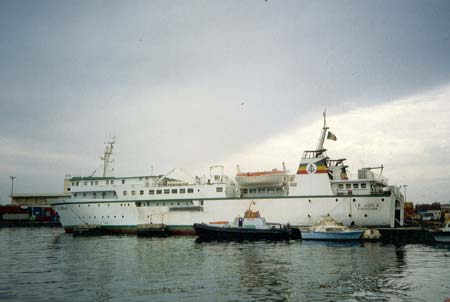
"Le Joola" bound for Zuiginchor, Dakar 2000 (WS)
|
In Gambia the horribly crowded car ferry Banjul - Barra of the Gambia Public Transport Corp. is crossing the mouth of the Gambia River. It formed a link in the road traffic between the capital Banjul and neighbouring Senegal. Only around 2005 the timetable listed also a new Pleasureresorts line Banjul - Dakar. In Guinea Bissau the Ministerio das Obras Publicas maintained a service between the port of Bissau and Boloma. About oil-rich Nigeria, Ortel/ Foerster reported: "Between Lagos, Nigeria, and Abidjan, Ivory Coast, the "Eunice of Ecowas" operated for Atlantic Ferries until 1997 (...). Built in 1960 as "Primula" for the Helsingor - Helsingborg route, she served in the 80s in the Netherlands. In 1997 she was renamed "El Shaddai" and sold from Atlantic Seaford (Atlantic Ferries) to a company with the name Redffern Ocean. She continues services in the seas of Nigeria". In the new century, Cook's timetable did no longer list any service in this country.
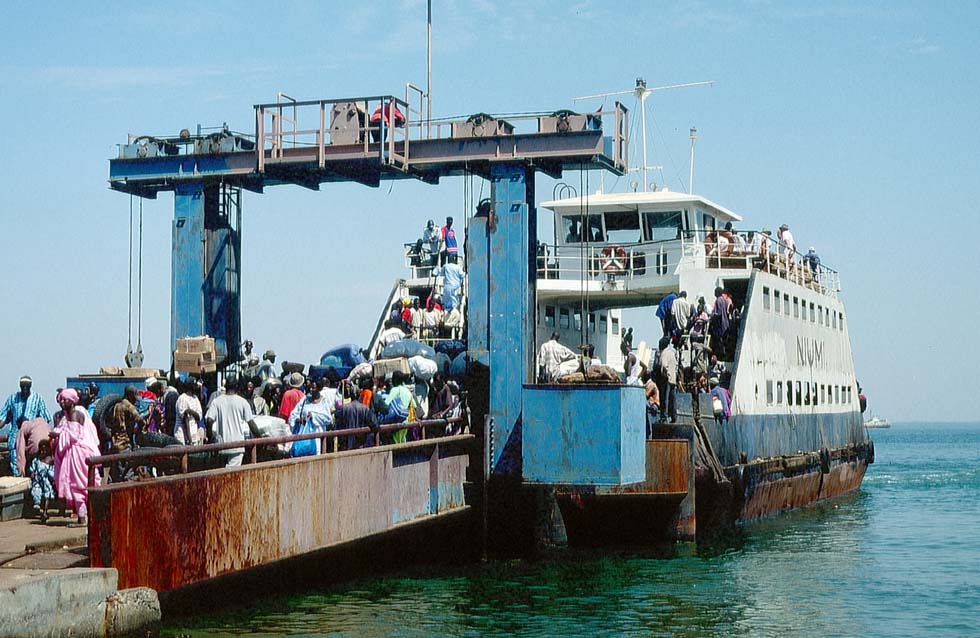
"Niumi" at Banjul after arrival from Barra, 2000 (WS)
In Congo-Kinshasa a service Banana - Matadi in the mouth of the Congo river by ONATRA appeared for some time in the timetables. About a ferry in Equatorial Guinea linking the capital Malabo, situated on an island, only a report in the weekly Der Spiegel (35/2006) gave a hint: "Power and haughtiness is represented by the sumptuous SUVs, by the facades of the office buildings, by the sparkling sunglasses of the cops who cudgel the passengers boarding the ferry...". About Angola, Ortel/ Foerster had informed: "In 1996 the Portuguese ferry "Lusitania Expresso" provided services in Angola. The ship, built in 1964 in Norway as "Spervik I" (...) and employed after 1969 as "Roslagen" (in the Baltic Sea), belongs to the Portuguese shipping firm Comtramar (Companhia de Transportes Maritimos)". Cook's timetable gave no hint. What survived in the south of Africa even in the 21st century is the Cape Town - St. Helena - Ascension service by Andrew Weir Shipping with the "RMS St Helena", coming from Portland.
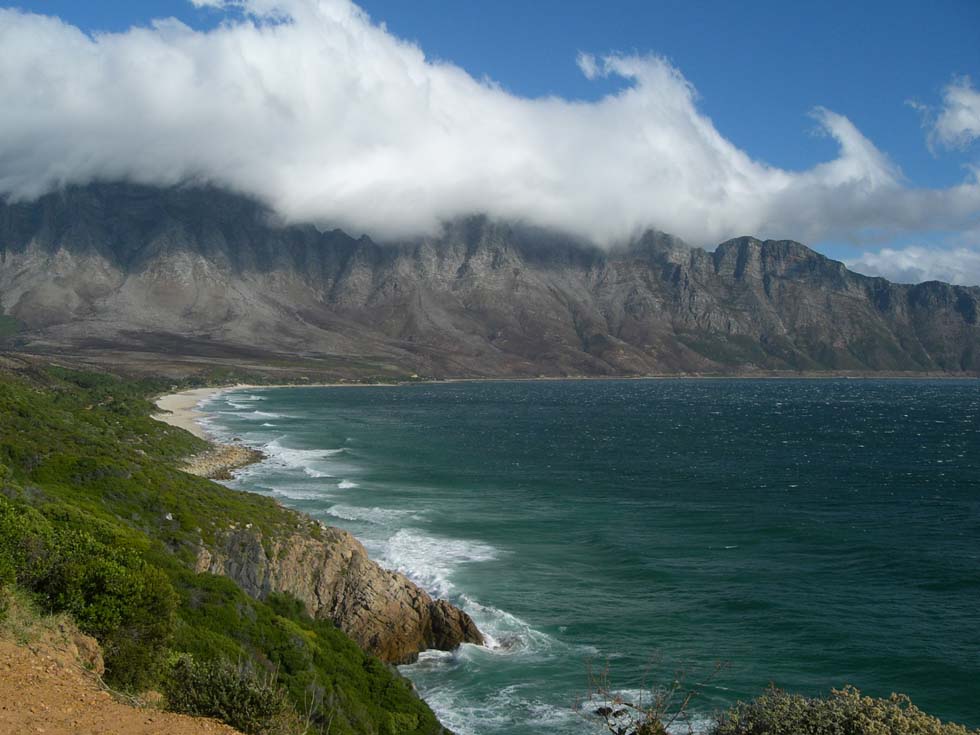
South Africa, False Bay (WS)
|